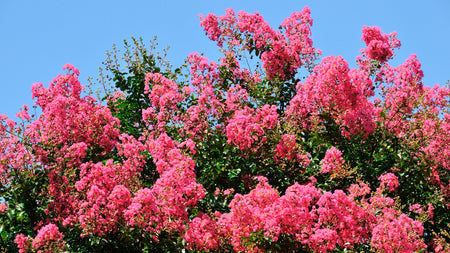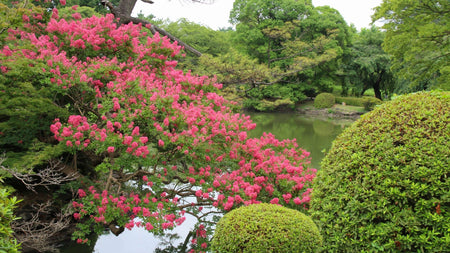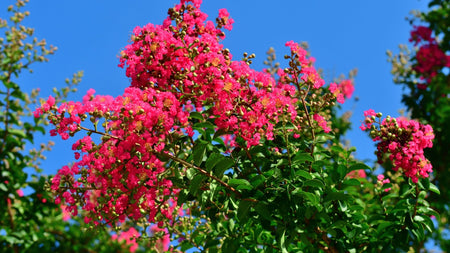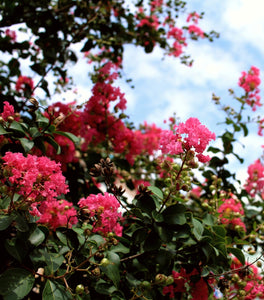
Images Depict Mature Plants
Crape Myrtle Pocomoke Shrubs
Pocomoke Crape Myrtle is a true dwarf variety that delivers a powerful punch of color in a small, easy-to-manage package. Reaching just 2 to 3 feet tall and wide at maturity, Pocomoke is perfect for tight spaces, container gardens, foundation plantings, and vibrant low borders. It produces abundant clusters of rich rosy-pink flowers from midsummer through fall, creating a lively, long-lasting display that brightens any sunny garden. Its compact, mounded habit and dense foliage make it a natural choice for adding structure and vivid color to small landscape areas.
Adaptable and easy to grow, Pocomoke Crape Myrtle thrives in full sun and well-draining soil, showing excellent resistance to common diseases like powdery mildew and leaf spot. Once established, it becomes highly drought tolerant, making it ideal for water-wise gardens and sustainable landscaping projects. Pocomoke requires minimal maintenance, needing only light pruning to maintain its naturally rounded form. Its glossy green foliage provides a beautiful backdrop for the vivid blooms and may offer attractive fall color as the season changes.
In addition to its striking beauty, Pocomoke Crape Myrtle is a magnet for pollinators, attracting bees, butterflies, and other beneficial insects to the garden. Whether used as a colorful edging plant, a cheerful accent in a container, or mass-planted for a dramatic groundcover effect, Pocomoke adds continuous interest and life to the landscape. With its compact size, vibrant flowers, and tough, resilient nature, Pocomoke Crape Myrtle is an outstanding choice for gardeners seeking bold color and low-maintenance charm in a small-scale design.

| Hardiness Zone: | 6-9 |
|---|---|
| Mature Height: | 2 to 3 feet |
| Mature Width: | 3 feet |
| Sunlight: | Full sun to part Sun |
| Habit: | Deciduous, densely branched, compact mound. |
| Classification: | Dwarf / Miniature |
| Flower Color: | Deep rose-pink flowers in mid to late summer through early Fall |
| Foliage: | Small, glossy, dark green foliage emerges maroon; bronze red fall color. Highly tolerant to powdery mildew. |
| Soil Condition: | Any well drained soil |
| Water: | Water well until established. |
| Uses: | Extremely attractive when used in the mixed border, mass planting, or part of a perennial garden. Also try them in containers on the patio. |
How to Care for Pocomoke Crape Myrtle
Be sure to read our planting instructions to ensure a healthy and happy Crape Myrtle Pocomoke Shrub for years to come!
How should I Plant my Pocomoke Crape Myrtles?
To plant your Pocomoke Crape Myrtles, start by selecting a sunny location that receives at least six hours of direct sunlight daily for optimal blooming and healthy growth. Dig a hole that is twice as wide and as deep as the root ball, and loosen the surrounding soil to encourage good root establishment. Place the shrub in the center of the hole with the top of the root ball level with or slightly above the soil surface. Backfill with native soil mixed with compost or organic matter to improve drainage and soil structure, and water thoroughly after planting to settle the soil and eliminate air pockets. A 2–3 inch layer of mulch around the base helps retain moisture and suppress weeds, but be sure to keep mulch away from the trunk. When planting Pocomoke Crape Myrtles, allow proper spacing—typically 2 to 4 feet apart—if you’re creating a low hedge, mass planting, or edging along a walkway or garden bed. Because Pocomoke is a true dwarf Crape Myrtle that matures at just 2 to 3 feet tall and wide, it’s also an excellent candidate for container gardening or small-space landscapes. Water consistently during the first growing season to establish a deep, healthy root system. With the right planting location, proper soil preparation, and a little care during establishment, your Pocomoke Crape Myrtles will reward you with a dense, colorful, and easy-care display of rich rosy-pink blooms from summer into fall.
How should I Water my Pocomoke Crape Myrtles?
When watering your Pocomoke Crape Myrtles, focus on deep, consistent soakings rather than frequent, shallow watering—especially during the first growing season. Water your Pocomoke thoroughly once or twice a week, depending on rainfall and temperature, ensuring the soil stays evenly moist but not saturated. Always water at the base of the plant to avoid wetting the foliage, which helps prevent common diseases like powdery mildew. Deep watering encourages the development of strong, deep roots, which will make your dwarf Crape Myrtles more drought-tolerant as they mature. Once established, Pocomoke Crape Myrtles become highly drought tolerant and generally only require watering during extended dry spells or particularly hot weather. A 2–3 inch layer of mulch around the base of the shrub will help retain soil moisture, regulate temperature, and reduce the need for frequent watering. Check the soil about 2 inches below the surface—if it feels dry, it's time to water. With proper watering techniques, your Pocomoke Crape Myrtles will stay healthy, vibrant, and covered in beautiful rosy-pink blooms all summer long.
How should I Fertilize my Pocomoke Crape Myrtles?
To fertilize your Pocomoke Crape Myrtles, apply a balanced, slow-release fertilizer such as 10-10-10 or 12-4-8 in early spring as new growth begins to emerge. Spread the fertilizer evenly around the root zone, keeping it a few inches away from the base of the plant, and water it in thoroughly to activate the nutrients. Fertilizing at this stage will support lush foliage, strong root development, and abundant rosy-pink blooms throughout the growing season. Avoid high-nitrogen fertilizers, which may promote excessive leafy growth at the expense of flowers. For continued health and blooming power, you can fertilize your Pocomoke Crape Myrtles again in midsummer with a lighter application, especially if growth appears sluggish or flowering has decreased. Additionally, incorporating organic compost or aged manure around the base of the plant can enhance soil fertility naturally and improve overall plant vigor. Always follow the recommended rates on fertilizer packaging to prevent overfeeding. With the right fertilization routine, Pocomoke Crape Myrtles will thrive in your garden, offering rich seasonal color in a compact, low-maintenance form.

How and When should I Prune my Pocomoke Crape Myrtles?
You should prune your Pocomoke Crape Myrtles in late winter or very early spring, before new growth begins to emerge. This timing allows you to shape the plant while it is dormant and ensures you won't remove developing flower buds, which form on new wood. Begin by removing any dead, damaged, or crossing branches to encourage healthy growth and improve air circulation. Since Pocomoke is a naturally compact dwarf variety, heavy pruning is not necessary—light shaping and thinning will help maintain its tidy, rounded form and maximize blooming. When pruning your Pocomoke Crape Myrtles, avoid cutting back the main stems severely, a practice known as “crape murder,” which is unnecessary for this small shrub. Instead, focus on refining its natural structure by snipping away any unwanted suckers at the base and selectively thinning overly dense areas. You can also remove spent flower clusters during the growing season to encourage a second round of blooms. With minimal, careful pruning at the right time, your Pocomoke Crape Myrtles will remain healthy, beautiful, and covered in vibrant rosy-pink flowers year after year.


















